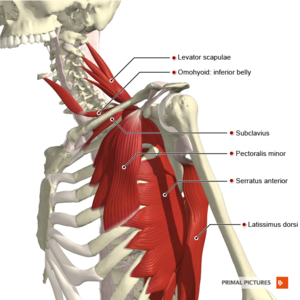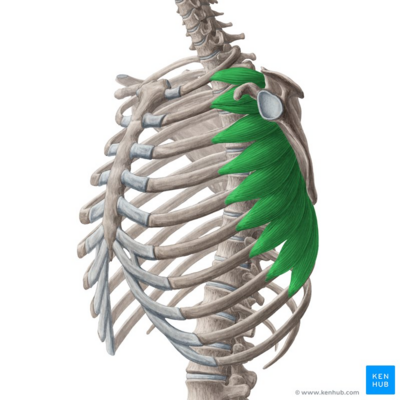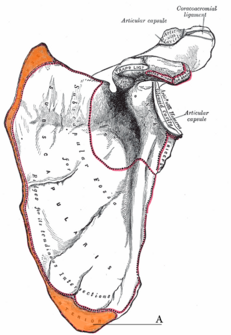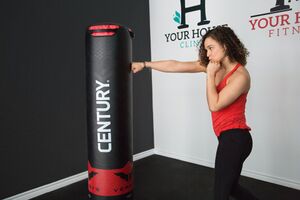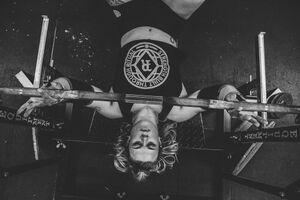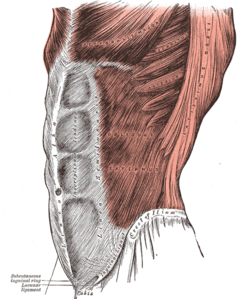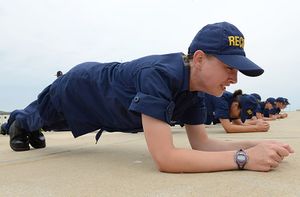Serratus Anterior: Difference between revisions
No edit summary |
Kim Jackson (talk | contribs) m (Text replacement - "brachial plexus" to "brachial plexus") |
||
| (39 intermediate revisions by 6 users not shown) | |||
| Line 1: | Line 1: | ||
<div class="editorbox"> | |||
'''Original Editor '''- [[User:Esraa Mohamed Abdullzaher|Esraa Mohamed Abdullzaher]] | |||
''' | '''Top Contributors''' - {{Special:Contributors/{{FULLPAGENAME}}}} </div> | ||
== Introduction == | |||
[[File:Muscles connecting the upper limb to the trunk deep muscles Primal.png|right|frameless]] | |||
The serratus anterior (SA) is a fan-shaped muscle that originates on the superolateral surfaces of the first to eighth or ninth ribs at the lateral wall of the thorax and inserts along the superior angle, medial border, and inferior angle of the scapula. Its main part lies deep under the [[scapula]] and the [[Pectoralis major|pectoral muscles]].<ref name=":2" /> | |||
* It acts on the scapula and is the prime mover in both scapular protraction and scapular upward rotation. | |||
* Is a key scapular stabilizer, keeping the shoulder blades against the ribcage when at rest and during movement.<ref name=":4">King of the gym Serratus anterior Available:https://www.kingofthegym.com/serratus-anterior/ (accessed 9.1.2022)</ref>. | |||
Image 1: Serratus Anterior. | |||
== Origin == | |||
[[File:Serratus anterior muscle - Kenhub.png|alt=Serratus anterior muscle - lateral view|right|frameless|400x400px|Serratus anterior muscle - lateral view <ref>Serratus anterior muscle - lateral view. Image from: © Kenhub - Illustrator: Yousun Koh https://www.kenhub.com/en/library/anatomy/serratus-anterior-muscle</ref>]] | |||
It originates on the top lateral surface of the eight or nine upper [[ribs]]. <ref name=":0">https://www.healthline.com/human-body-maps/serratus-anterior-muscle#2</ref> It then wraps posteromedially around the ribcage, passing beneath the scapula to insert on the underside of the scapula on its medial border. | |||
As the muscle extends from the ribs, it is divided by tendinous septa into nine finger-like groupings of muscle fibers called “digitations.” | |||
* The fibers run obliquely (to varying degrees) between these septa, forming a multipennate muscle architecture. | |||
The | * Upper three digitations are termed the superior fibers , lower six digitations are termed the inferior fibers. | ||
* The lowest four digitations of the serratus anterior interdigitate with the fibers of the external oblique. | |||
Image 2: Serratus anterior muscle seen from a lateral view. <ref > Serratus anterior muscle - lateral view image: © Kenhub https://www.kenhub.com/en/library/anatomy/serratus-anterior-muscle</ref> | |||
== | == Insertion== | ||
It inserts | [[File:Serratus Anterior origin .png|right|frameless|alt=|335x335px]] | ||
The muscle is divided into three parts : | It inserts on the front border of the scapula.<ref name=":0" /> The muscle is divided into three parts : | ||
* Upper / Superior : 1st to 2nd rib → superior angle of scapula. | * Upper / Superior : 1st to 2nd rib → superior angle of scapula. | ||
* Middle / Intermedius : 2nd to 3rd rib → medial border of scapula. | * Middle / Intermedius : 2nd to 3rd rib → medial border of scapula. | ||
* Lower / Inferior : 4th to 9th rib → medial border and inferior angle of scapula. | * Lower / Inferior : 4th to 9th rib → medial border and inferior angle of scapula. It is the most powerful and prominent part.<ref name=":1">''M. Schünke/E. Schulte/U. Schumacher''''':''' Prometheus – LernAtlas der Anatomie – Allgemeine Anatomie und Bewegungssystem, 2.Auflage, Thieme Verlag (2007), S.294-295 | ||
J. E. Muscolino''':''' The muscular system manual – The skeletal muscles of the human body, 2.Auflage, Elsevier Mosby (2005), S.214-217 | |||
P. Berlit: Klinische Neurologie, 3.Auflage, Springer Verlag (2011), S.345 | |||
[https://www.kenhub.com/en/library/anatomy/serratus-anterior-muscle] | |||
</ref> | |||
Image 3: Insertional area of SA on scapula. | |||
== Nerve and Blood Supply == | |||
# The long thoracic [[Neurone|nerve]], which arises from C5 to C7 nerve roots of the [[Brachial Plexus|brachial plexus]].<ref name=":2">Lung K, Lui F. [https://www.ncbi.nlm.nih.gov/books/NBK531457/ Anatomy, thorax, serratus anterior muscles.] StatPearls [Internet]. 2020 Jul 10. Available: https://www.ncbi.nlm.nih.gov/books/NBK531457/ (accessed 9.1.2022)</ref> | |||
# Lateral thoracic [[Arteries|artery]], the superior thoracic artery and the thoracodorsal artery.<ref name=":2" /> | |||
== Function == | |||
[[File:Boxing gym.jpeg|right|frameless]] | |||
The main actions are protraction and upward rotation of the [[Scapulothoracic Joint|scapulothoracic joint]].<ref>Richard D. Gray’s anatomy for students.</ref> | |||
It’s also a key scapular stabilizer, keeping the shoulder blades against the ribcage when at rest and during movement. It also acts with the upper and lower fibers of the trapezius muscle to sustain upward rotation of the scapula, which allows for overhead arm movement<ref name=":2" />. See [[Dynamic Stabilisers of the Shoulder Complex]] and [[Scapulohumeral Rhythm]]. | |||
[[File:Bower.jpeg|right|frameless]] | |||
When the shoulder blade is in fixed position the [[Muscles of Respiration|accessory inspiratory muscles]] (used in respiratory distress) are activated e.g breathing after a boxing bout, person with [[emphysema]]. The serratus anterior lifts the ribcage and thus supports breathing.<ref name=":1" />The other accessory inspiratory muscles include sternocleidomastoid, scalene muscles, pectoralis major, pectoralis minor, trapezius, latissimus dorsi, erector spinae, iliocostalis lumborum, quadratus lumborum<ref>Ken hub [https://www.kenhub.com/en/library/anatomy/anatomy-of-breathing Anatomy of breathing] Available:https://www.kenhub.com/en/library/anatomy/anatomy-of-breathing (accessed 9.1.2022)</ref> | |||
Image 4: The serratus anterior is also known as the “boxer’s muscle,” as it is largely responsible for the protraction of the scapula which occurs when throwing a punch. | |||
Image 5: When the shoulder blade is in fixed position the [[Muscles of Respiration|accessory inspiratory muscles]] (used in respiratory distress) are activated. | |||
==Clinical Relevance== | |||
[[File:Bench press.jpeg|right|frameless]] | |||
The most common causes of serratus muscle pain include: tension; [[Stress and Health|stress]]; overuse. | |||
* It is is common in sports with repetitive motions, eg swimming, tennis, or weightlifting (especially with heavy weights). | |||
* This pain may also result from serratus anterior myofascial pain syndrome (SAMPS), a rare [[Myofascial Pain|myofascial pain]] syndrome.<ref>Health Line Serratus Anterior Available: https://www.healthline.com/health/serratus-anterior-pain#causes (accessed 9.1.2022)</ref> | |||
Image 6: Bench press, stresses SA | |||
[https://www. | When the serratus anterior is inhibited, lengthened or weakened, scapular protraction and scapular upward rotation are impaired. This limits overhead range of motion and reduces overall scapular/shoulder stability, increasing the risk of injury to the rotator cuff and shoulder girdle. Common causes for this include: | ||
</ref> | |||
*[[Upper-Crossed Syndrome|Upper Crossed Syndrome]] | |||
* Damage to the long thoracic nerve can weaken, or even paralyze, the serratus anterior. Neurogenic scapular winging (i.e. [[Winged scapula|scapular winging]] caused by [[Neuropathies|nerve damage]]) requires a doctor to verify if scapular winging is neurogenic<ref name=":4" />. | |||
* Weakness of the serratus anterior leads to altered line of pull of the [[Rotator Cuff|rotator cuff]] muscle which could increase the risk of [[Subacromial Pain Syndrome|subacromial impingement syndrome]].<ref name=":3">Neumann DA, Camargo PR. [https://www.ncbi.nlm.nih.gov/pmc/articles/PMC6849091/ Kinesiologic considerations for targeting activation of scapulothoracic muscles-part 1: serratus anterior.] Brazilian journal of physical therapy. 2019 Nov 1;23(6):459-66.</ref> | |||
==Assessment== | |||
[[File:Axilla .png|right|frameless|300x300px]] | |||
=== | === Palpation === | ||
The | The serratus anterior muscle is very thin and covers the side of the ribcage. The main part of the serratus anterior lies deep to the scapula and the pectoral muscles and is easily palpated between the pectoralis major and latissimus dorsi muscles.<ref name=":2" /> | ||
Image 7: SA seen her between the pectoralis major and latissimus dorsi muscles. | |||
* You can feel it by putting your hand just below the arm pit. | * You can feel it by putting your hand just below the arm pit. | ||
* It also helps to experience how your ribs feel, so that you can distinguish the ribs and this thin and superficial muscle. | * It also helps to experience how your ribs feel, so that you can distinguish the ribs and this thin and superficial muscle. | ||
[ | === Muscle Test === | ||
</ | The 3 tests below can be used to examine the serratus anterior muscle weakness and scapula winging | ||
== | # [[Serratus Anterior Strength Test or ( Punch out test )|Serratus Anterior Strength Test or Push Out Test]] is used to examine the serratus anterior muscle weakness and scapula winging. <ref>David J. Magee. Orthopedic Physical Assessment. 6th edition. Elsevier. 2014.</ref> | ||
# Shoulder abduction test. Therapist applies a downwards resisting force against the scapular plane abduction of the shoulder at about 120–130° and against upward rotation of the scapula. A weak serratus anterior would result in the patient failing to resist the therapist’s force resulting in the shoulder breaking into adduction and the scapula can't rotate upwards significantly. <ref name=":3" /> | |||
# In the third test the patient is in a seated or supine position, with his arm flexed 90-100 degrees and his elbow fully extended. The therapist resists the maximally protracting force by the patient. In case of serratus anterior muscle weakness the patient’s scapula is pushed into a retracted and internally rotated position leading to scapular winging appearance.<ref name=":3" />See video below. | |||
{{#ev:youtube|9Jqy6CoknGU}} | |||
== | |||
== Exercises for Activating Serratus Anterior == | |||
[[File:Plank exercise.jpg|right|frameless]] | |||
The serratus anterior is trained indirectly in all anterior [[deltoid]] exercises. It works to some extent in the select few chest exercises that involve scapular protraction A few examples include: | |||
* Isometric Exercises: [[Plank exercise|Plank]] (emphasizing protraction); Straight arm plank (emphasizing protraction) | |||
* Incline shoulder raise | |||
* Flat shoulder raise | |||
* Overhead shrug | |||
* [[Press-Up|Push-up plus]] | |||
* Serratus anterior punch<ref name=":3" /> | |||
Image 8: Plank exercise. | |||
== Resources== | |||
Watch this comprehensive video from Kenhub (3 minutes) <ref > Serratus anterior muscle video - © Kenhub https://www.kenhub.com/en/library/anatomy/serratus-anterior-muscle</ref> | |||
{{#ev:youtube|kTxqYkDdle4}} | {{#ev:youtube|kTxqYkDdle4}} | ||
== | |||
== References== | |||
<references /> | <references /> | ||
[[Category:Anatomy]] [[Category:Muscles]] | [[Category:Anatomy]] | ||
[[Category:Muscles]] | |||
[[Category:Shoulder - Anatomy]] | |||
[[Category:Shoulder - Muscles]] | |||
Latest revision as of 19:02, 8 March 2024
Original Editor - Esraa Mohamed Abdullzaher
Top Contributors - Lucinda hampton, Kholoud Abd Elghany, Kim Jackson, Joao Costa, Lilian Ashraf, Esraa Mohamed Abdullzaher and Oyemi SilloIntroduction[edit | edit source]
The serratus anterior (SA) is a fan-shaped muscle that originates on the superolateral surfaces of the first to eighth or ninth ribs at the lateral wall of the thorax and inserts along the superior angle, medial border, and inferior angle of the scapula. Its main part lies deep under the scapula and the pectoral muscles.[1]
- It acts on the scapula and is the prime mover in both scapular protraction and scapular upward rotation.
- Is a key scapular stabilizer, keeping the shoulder blades against the ribcage when at rest and during movement.[2].
Image 1: Serratus Anterior.
Origin[edit | edit source]
It originates on the top lateral surface of the eight or nine upper ribs. [4] It then wraps posteromedially around the ribcage, passing beneath the scapula to insert on the underside of the scapula on its medial border.
As the muscle extends from the ribs, it is divided by tendinous septa into nine finger-like groupings of muscle fibers called “digitations.”
- The fibers run obliquely (to varying degrees) between these septa, forming a multipennate muscle architecture.
- Upper three digitations are termed the superior fibers , lower six digitations are termed the inferior fibers.
- The lowest four digitations of the serratus anterior interdigitate with the fibers of the external oblique.
Image 2: Serratus anterior muscle seen from a lateral view. [5]
Insertion[edit | edit source]
It inserts on the front border of the scapula.[4] The muscle is divided into three parts :
- Upper / Superior : 1st to 2nd rib → superior angle of scapula.
- Middle / Intermedius : 2nd to 3rd rib → medial border of scapula.
- Lower / Inferior : 4th to 9th rib → medial border and inferior angle of scapula. It is the most powerful and prominent part.[6]
Image 3: Insertional area of SA on scapula.
Nerve and Blood Supply[edit | edit source]
- The long thoracic nerve, which arises from C5 to C7 nerve roots of the brachial plexus.[1]
- Lateral thoracic artery, the superior thoracic artery and the thoracodorsal artery.[1]
Function[edit | edit source]
The main actions are protraction and upward rotation of the scapulothoracic joint.[7]
It’s also a key scapular stabilizer, keeping the shoulder blades against the ribcage when at rest and during movement. It also acts with the upper and lower fibers of the trapezius muscle to sustain upward rotation of the scapula, which allows for overhead arm movement[1]. See Dynamic Stabilisers of the Shoulder Complex and Scapulohumeral Rhythm.
When the shoulder blade is in fixed position the accessory inspiratory muscles (used in respiratory distress) are activated e.g breathing after a boxing bout, person with emphysema. The serratus anterior lifts the ribcage and thus supports breathing.[6]The other accessory inspiratory muscles include sternocleidomastoid, scalene muscles, pectoralis major, pectoralis minor, trapezius, latissimus dorsi, erector spinae, iliocostalis lumborum, quadratus lumborum[8]
Image 4: The serratus anterior is also known as the “boxer’s muscle,” as it is largely responsible for the protraction of the scapula which occurs when throwing a punch.
Image 5: When the shoulder blade is in fixed position the accessory inspiratory muscles (used in respiratory distress) are activated.
Clinical Relevance[edit | edit source]
The most common causes of serratus muscle pain include: tension; stress; overuse.
- It is is common in sports with repetitive motions, eg swimming, tennis, or weightlifting (especially with heavy weights).
- This pain may also result from serratus anterior myofascial pain syndrome (SAMPS), a rare myofascial pain syndrome.[9]
Image 6: Bench press, stresses SA
When the serratus anterior is inhibited, lengthened or weakened, scapular protraction and scapular upward rotation are impaired. This limits overhead range of motion and reduces overall scapular/shoulder stability, increasing the risk of injury to the rotator cuff and shoulder girdle. Common causes for this include:
- Upper Crossed Syndrome
- Damage to the long thoracic nerve can weaken, or even paralyze, the serratus anterior. Neurogenic scapular winging (i.e. scapular winging caused by nerve damage) requires a doctor to verify if scapular winging is neurogenic[2].
- Weakness of the serratus anterior leads to altered line of pull of the rotator cuff muscle which could increase the risk of subacromial impingement syndrome.[10]
Assessment[edit | edit source]
Palpation[edit | edit source]
The serratus anterior muscle is very thin and covers the side of the ribcage. The main part of the serratus anterior lies deep to the scapula and the pectoral muscles and is easily palpated between the pectoralis major and latissimus dorsi muscles.[1]
Image 7: SA seen her between the pectoralis major and latissimus dorsi muscles.
- You can feel it by putting your hand just below the arm pit.
- It also helps to experience how your ribs feel, so that you can distinguish the ribs and this thin and superficial muscle.
Muscle Test[edit | edit source]
The 3 tests below can be used to examine the serratus anterior muscle weakness and scapula winging
- Serratus Anterior Strength Test or Push Out Test is used to examine the serratus anterior muscle weakness and scapula winging. [11]
- Shoulder abduction test. Therapist applies a downwards resisting force against the scapular plane abduction of the shoulder at about 120–130° and against upward rotation of the scapula. A weak serratus anterior would result in the patient failing to resist the therapist’s force resulting in the shoulder breaking into adduction and the scapula can't rotate upwards significantly. [10]
- In the third test the patient is in a seated or supine position, with his arm flexed 90-100 degrees and his elbow fully extended. The therapist resists the maximally protracting force by the patient. In case of serratus anterior muscle weakness the patient’s scapula is pushed into a retracted and internally rotated position leading to scapular winging appearance.[10]See video below.
Exercises for Activating Serratus Anterior[edit | edit source]
The serratus anterior is trained indirectly in all anterior deltoid exercises. It works to some extent in the select few chest exercises that involve scapular protraction A few examples include:
- Isometric Exercises: Plank (emphasizing protraction); Straight arm plank (emphasizing protraction)
- Incline shoulder raise
- Flat shoulder raise
- Overhead shrug
- Push-up plus
- Serratus anterior punch[10]
Image 8: Plank exercise.
Resources[edit | edit source]
Watch this comprehensive video from Kenhub (3 minutes) [12]
References[edit | edit source]
- ↑ 1.0 1.1 1.2 1.3 1.4 Lung K, Lui F. Anatomy, thorax, serratus anterior muscles. StatPearls [Internet]. 2020 Jul 10. Available: https://www.ncbi.nlm.nih.gov/books/NBK531457/ (accessed 9.1.2022)
- ↑ 2.0 2.1 King of the gym Serratus anterior Available:https://www.kingofthegym.com/serratus-anterior/ (accessed 9.1.2022)
- ↑ Serratus anterior muscle - lateral view. Image from: © Kenhub - Illustrator: Yousun Koh https://www.kenhub.com/en/library/anatomy/serratus-anterior-muscle
- ↑ 4.0 4.1 https://www.healthline.com/human-body-maps/serratus-anterior-muscle#2
- ↑ Serratus anterior muscle - lateral view image: © Kenhub https://www.kenhub.com/en/library/anatomy/serratus-anterior-muscle
- ↑ 6.0 6.1 M. Schünke/E. Schulte/U. Schumacher: Prometheus – LernAtlas der Anatomie – Allgemeine Anatomie und Bewegungssystem, 2.Auflage, Thieme Verlag (2007), S.294-295 J. E. Muscolino: The muscular system manual – The skeletal muscles of the human body, 2.Auflage, Elsevier Mosby (2005), S.214-217 P. Berlit: Klinische Neurologie, 3.Auflage, Springer Verlag (2011), S.345 [1]
- ↑ Richard D. Gray’s anatomy for students.
- ↑ Ken hub Anatomy of breathing Available:https://www.kenhub.com/en/library/anatomy/anatomy-of-breathing (accessed 9.1.2022)
- ↑ Health Line Serratus Anterior Available: https://www.healthline.com/health/serratus-anterior-pain#causes (accessed 9.1.2022)
- ↑ 10.0 10.1 10.2 10.3 Neumann DA, Camargo PR. Kinesiologic considerations for targeting activation of scapulothoracic muscles-part 1: serratus anterior. Brazilian journal of physical therapy. 2019 Nov 1;23(6):459-66.
- ↑ David J. Magee. Orthopedic Physical Assessment. 6th edition. Elsevier. 2014.
- ↑ Serratus anterior muscle video - © Kenhub https://www.kenhub.com/en/library/anatomy/serratus-anterior-muscle
